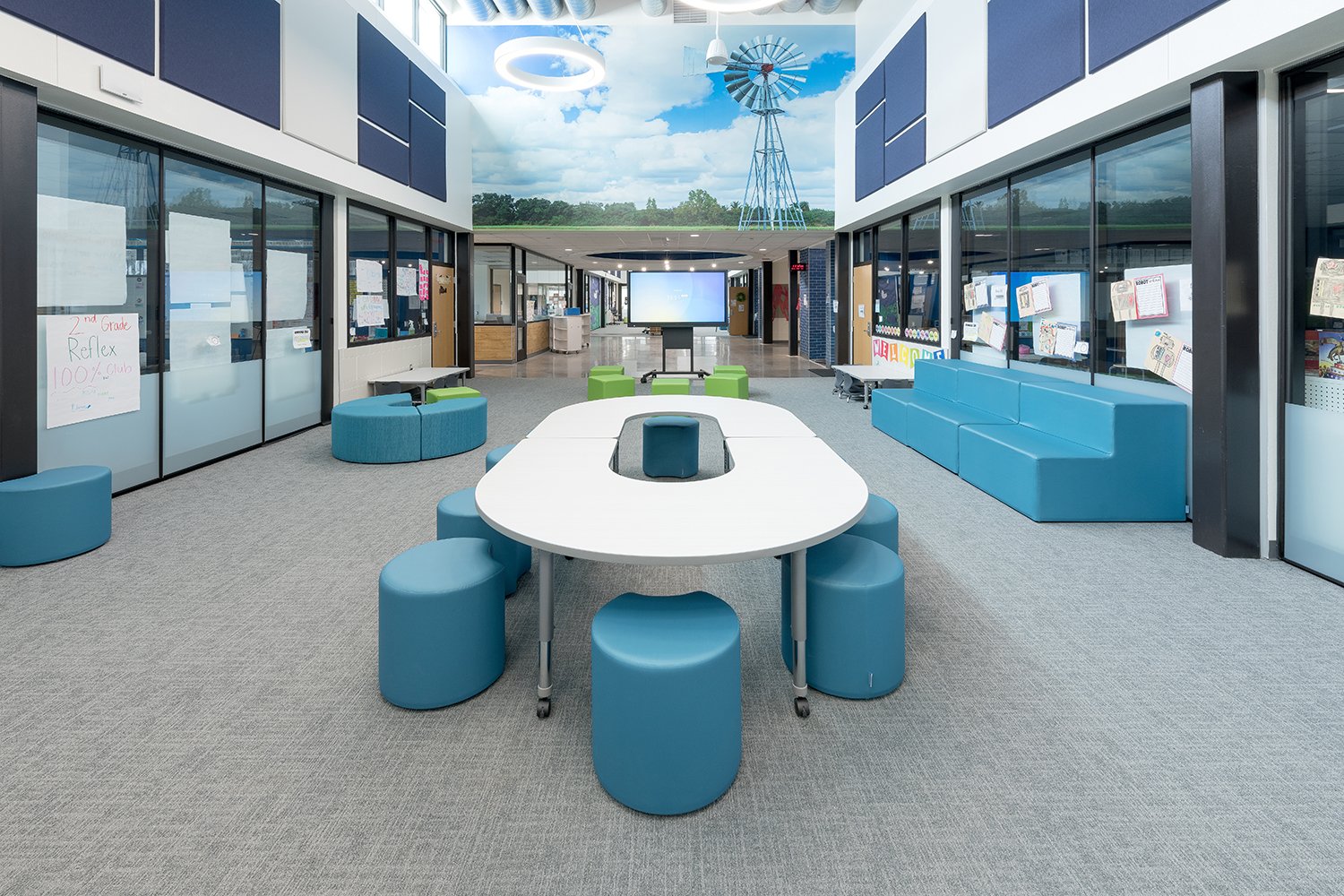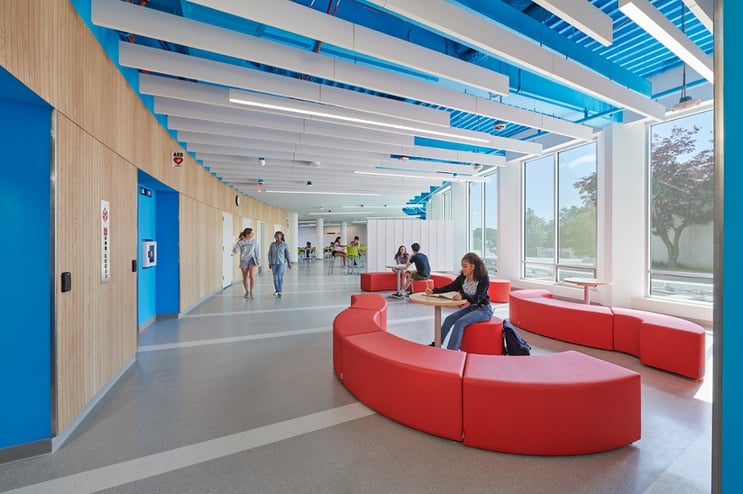maximizing learning potential: innovative ideas for hallway design in schools
Space is at a premium within a school building. Using every bit of space helps create opportunities for students to engage. These environments can be small for personal instruction or individual study or larger spaces to accommodate collaborative groups.

tips for designing learning hallways
Learning hallways are often overlooked spaces in schools, but they have the potential to be valuable extensions of the classroom. By utilizing learning hallways effectively, schools can maximize their available space and create additional opportunities for students to engage in various educational activities. Here are some practical tips for designing hallways as learning zones:
-
- Create interactive displays: Incorporate interactive elements into hallway displays to encourage student participation. For example, you could have puzzles, trivia questions, or thought-provoking prompts that students can interact with during passing periods or while waiting.
- Provide learning resources: Use hallway space to offer educational resources, such as bookshelves with books, magazines, or other reading materials related to various subjects. Consider adding QR codes or short summaries with recommendations to pique students' interest.
- Incorporate technology: Install interactive screens or digital displays in the hallway to provide educational content, announcements, or interactive learning activities. These can be used for quizzes, trivia games, or even virtual field trips to engage students as they walk through the hallways.
- Design comfortable seating areas: Include seating nooks or benches along the hallway walls to create spaces for students to sit, relax, and study. These areas can be enhanced with cushions, plants, or other cozy elements that encourage informal learning and collaboration.
- Use murals and graphics: Commission local artists or involve students in creating vibrant and educational murals or graphics on the walls. These can visually represent concepts from different subjects, historical events, or inspirational quotes that promote a positive learning environment.
- Incorporate natural elements: Introduce natural elements like plants, vertical gardens, or aquariums to create a calming and visually appealing environment. Research suggests that exposure to nature can improve focus and reduce stress, enhancing the overall learning experience.
- Provide writable surfaces: Dedicate specific sections of the hallway walls as writable surfaces using whiteboards or chalkboards. Students can use these spaces for brainstorming, problem-solving, or collaborative activities. Make sure to supply writing materials nearby.
- Enhance lighting and acoustics: Ensure that the hallway has adequate lighting to create a bright and inviting atmosphere. Additionally, consider using sound-absorbing materials, such as acoustic panels or carpets, to reduce noise levels and maintain a quieter learning environment.
- Engage students in the design process: Involve students in the design and decoration of the hallway spaces. Seek their input, ideas, and creativity to make the space truly their own. This empowers them, boosts their sense of ownership, and fosters a stronger connection to the learning environment.
- Display student work: Use hallway walls to showcase students' artwork, projects, and achievements. This not only celebrates their accomplishments but also creates a sense of pride and motivation. Regularly rotate the displays to keep them fresh and engaging.
Remember, when designing hallways as learning zones, safety and accessibility should always be prioritized. Ensure clear pathways, proper signage, and compliance with building codes and regulations.

helpful links to CLASSROOM DESIGN TRENDS
- Case Study: Georgetown, TX
- Color Psychology for Education
- Planning Typicals: Learning Hallways + Breakout Spaces
- Case Study: Arlington, Virginia
EXPLORE learning hallways SETUP IDEAS
Click through hallway ideas below or visit our image gallery of learning spaces designed to promote comfort, configurability, mobility, and accessibility in a variety of learning environments.

LEARNING STAIRS
The new multipurpose student-centered space provides both a formal and informal area for collaborating, teaching, socializing and performing in an amphitheater-style environment.

TECHNOLOGY INTEGRATED HALLWAYS
Enhance project-based learning and collaborative group work with shape tables. Flexibility promotes an active learning environment. This selection of furniture is a solution for creative classrooms, maker spaces or multi-purpose learning centers. Mobile, sit-to-stand desks and flexible seating provide movement.
CONNECTED LEARNING SPACES
Learning hallways can help to foster a sense of community among students and teachers by providing a shared space for learning and collaboration. This can help to promote a positive school culture and create a more supportive and inclusive learning environment.

TRANSFORM HALLWAYS INTO INTERACTIVE LEARNING SPACES
What changes can you make to turn your corridors into engaging and meaningful learning opportunities?

FLEXIBILITY PROMOTES ACTIVE LEARNING
Enhance project-based learning and collaborative group work with shape tables. Flexibility promotes an active learning environment. This selection of furniture is a solution for creative classrooms, maker spaces or multi-purpose learning centers. Mobile, sit-to-stand desks and flexible seating provide movement.

CREATE NOOKS
Curved mobile bookcases help reduce clutter by storing learning materials. Pair with soft seating you have a solution for students to relax and learn.

GET CREATIVE
Design a learning hallway to meet the flexibility you need. Configurable seating options can be moved around for groups or single students, then move out of the way when you need the space.

CARVE OUT NICHES
and cubbies in the library to create collaborative or contemplative zones where students can work on projects. Add casters and you can move tables to the side if you need open space for larger groups or community events.

FOUND SPACE
Create comfortable spaces in the hallway using café tables and stools for collaboration.

WELCOME TO THE NEIGHBORHOOD
The open space within grade-specific neighborhoods can become usable space for arts and sciences classes. Bring in tables for group work and offer a variety of seating options, from sit-on-the-floor to bar height. Don't forget to add lots of color for fun!

IMPROMPTU LEARNING ZONES
Use café tables and soft seating for students to have comfortable spaces to collaborate.

INBETWEEN SPACES
Use hallways to engage students in learning, interaction, and socialization outside of the formal classroom.
prime real estate
By effectively utilizing learning hallways, schools can maximize their available space and create additional opportunities for students to engage in various educational activities. It's time to rethink the traditional hallway and turn it into a valuable extension of the classroom.
Recent Posts
In part one of our series on thoughtful classroom design, we heard an educator’s perspective on...
In part one of our series on thoughtful classroom design, we heard an educator’s perspective on...

